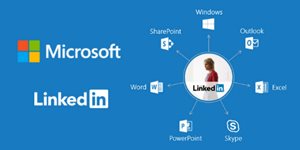LinkedIn Integration to Microsoft Dynamics Challenges Salesforce
Microsoft acquired LinkedIn last year for $26.2 billion, with an aim to integrate the most  popular professional social network with its cloud-based product line, including Office 365 and Dynamics 365. Three months after the deal was closed, the company announced its roadmap to make the first of its promised integrations between Dynamics 365 and LinkedIn, including integration with the LinkedIn Sales Navigator, available to customers this July. With the integration, users will be provided with contextual recommendations so they can create tailored content. The application will also deliver account and lead updates based on LinkedIn activity such as a job change.
popular professional social network with its cloud-based product line, including Office 365 and Dynamics 365. Three months after the deal was closed, the company announced its roadmap to make the first of its promised integrations between Dynamics 365 and LinkedIn, including integration with the LinkedIn Sales Navigator, available to customers this July. With the integration, users will be provided with contextual recommendations so they can create tailored content. The application will also deliver account and lead updates based on LinkedIn activity such as a job change.
“Last July we introduced Dynamics 365, powered by Microsoft Azure, turning what was rigid and disconnected into a set of intelligent cloud services that allow any business to start small with just what it needs, scale on demand as its needs grow and add additional solutions as its needs change,” stated Scott Guthrie, Executive Vice President for the Cloud and Enterprise Group at Microsoft. “With Dynamics 365 we deliver modern, intelligent experiences and services that connect all the data across your enterprise to help you make better, faster decisions and achieve optimal outcomes."
Microsoft claims that their single offer that brings together LinkedIn Sales Navigator and Dynamics 365 for Sales is at about half the cost of what they would pay for a competitor's solution in the CRM market. Guess who they are talking about? To be exact, the Microsoft Relationship Sales solution which includes Dynamics 365 for Sales, Enterprise Edition, and LinkedIn Sales Navigator Team will be available for $135 per seat per month before volume discounts. What are the benefits of this bundle you may ask? Here are the most significant capabilities of the new integrations between Sales Navigator and Dynamics 365 for Sales:
-
Displaying Sales Navigator person and company information on every Dynamics lead, contact, account and opportunity page.
-
Daily updates between systems, so the accounts and contacts sales reps are actively working on in Dynamics 365 are automatically saved to Sales Navigator. In addition, sales reps can see in Sales Navigator what people and companies have already saved in Dynamics, and vice-versa.
-
With a single click, the ability to write select Sales Navigator activities (InMails, messages, notes and call logs) to Dynamics 365.
This week, LinkedIn also announced that it has now passed 500 million registered users in 200 countries on its platform. Given this new milestone, Guthrie believes that Sales Navigator with Dynamics 365 will dramatically increase the effectiveness of salespeople by tapping into their professional networks and relationships. However, to take advantage of this combination, Microsoft Dynamics customers should also be LinkedIn customers.
Microsoft CEO Satya Nadella told Reuters that specialized applications in fields like sales and  finance are critical to the company's future. Furthermore, he views them as Microsoft's "third cloud," the first two being Office 365 for general productivity like email and Azure for computing and databases. His ultimate game plan is to have all products take advantage of a common set of business data that can be mined for new insights with artificial intelligence. He also stressed that they are not interested in replacing other specialized applications as they aim to provide game-changer solutions.
finance are critical to the company's future. Furthermore, he views them as Microsoft's "third cloud," the first two being Office 365 for general productivity like email and Azure for computing and databases. His ultimate game plan is to have all products take advantage of a common set of business data that can be mined for new insights with artificial intelligence. He also stressed that they are not interested in replacing other specialized applications as they aim to provide game-changer solutions.
360-Degree View of Workforce with Dynamics 365 for Talent
Microsoft also announced a new solution for HR organizations that integrates with LinkedIn Recruiter, called Dynamics 365 for Talent to help organizations find dynamic candidate profiles with the most up-to-date information, measure and maximize the effectiveness of their human resources through integrated intelligence, and tailor the onboarding process to each employee by providing them with targeted activities, learning resources, and access to relevant contacts.
With this integration, also arriving in July, Microsoft mostly aims at gaining an upper hand in its battle against Oracle and SAP.
Dynamics 365 for Retail Enables Customer Engagement
As another addition to the Dynamics 365 suite, Microsoft unveiled a new intelligent cloud service for retailers, called Dynamics 365 for Retail. The cloud-based solution offers retailers a centralized management over their customers, employees, financials and inventory across multiple store locations. Additionally, with the mobile-optimized point of sale capabilities and omnichannel features that allow shoppers to access personal account information or return merchandise to any physical location, Microsoft is aiming at helping organizations deliver data-driven retail experiences that leverage customer engagement at every touch point.
Other updates to Dynamics 365 include Dynamics 365 Business Edition apps for Sales and Marketing, focused on empowering small- and medium-sized businesses (SMBs) and a series of industry-specific SaaS solutions available in Microsoft AppSource. On top of it all, Microsoft shared its plans to deliver Dynamics 365 from local data centers in the U.K. and Germany in an effort to enable customers to meet the unique data and regulatory needs of their country and geographic area.
My POV
There are already connections between Dynamics 365 and Office 365 products, providing similar connections to LinkedIn in the face of stiff competition in the CRM market is an inevitable move for Microsoft. Though Nadella has a great vision and obviously, a clear roadmap for Dynamics, there are also facts telling that last year, Dynamics revenue grew just 4 percent versus 26 percent for Salesforce whose sales software accounted for $3 billion of its $8.3 billion overall revenue. Additionally, when it comes to AI capabilities, it is safe to say that Salesforce has been much more active rolling out the AI-powered solutions while Microsoft is still in the stage of development. Nevertheless, Microsoft is becoming a formidable challenger to the market leader, Salesforce, and the acquisition of LinkedIn has leveraged this mostly, but to me, it still seems like Microsoft is playing catch-up in the CRM space so I am not sure if the Redmond, Wash.-based tech titan can close the market adoption gap with Salesforce in the sales software space anytime soon.

Venus Tamturk
Venus is the Media Reporter for CMS-Connected, with one of her tasks to write thorough articles by creating the most up-to-date and engaging content using B2B digital marketing. She enjoys increasing brand equity and conversion through the strategic use of social media channels and integrated media marketing plans.